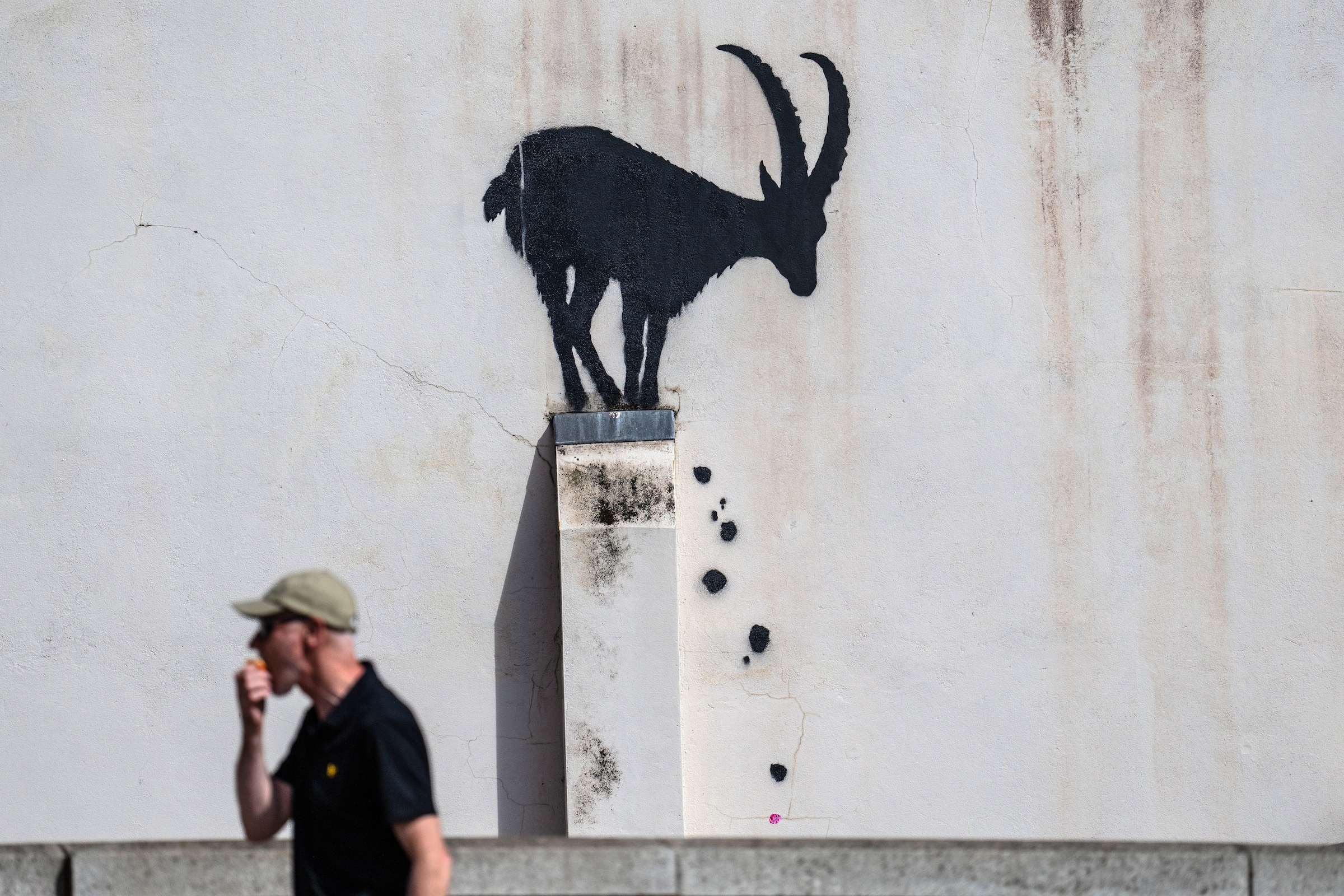The elusive British street artist Banksy struck twice in a row early this week, claiming credit on his Instagram for two separate murals in London. Both works portray threatened or endangered animals — a goat and two elephants — though the lack of context on the artist’s posts has spectators wondering what the murals signify and projecting their own meanings at a time of global political unrest.
But based on the available clues and Banksy’s past works, is it possible that he’s saying something about Palestine?
The first mural, a silhouette of what appears to be a Nubian Ibex goat, emerged on the side of a defunct manufacturing building along the south side of Kew Bridge on Monday, August 5, precariously perched on a tight ledge with a real CCTV camera directed at it. The artist followed up on Tuesday afternoon with a second mural of two stenciled elephants extending their trunks to each other from adjacent window sills on the side of what appears to be a home in London’s Chelsea neighborhood.
Back in Kew, the Nubian Ibex teeters on an unceremonious pedestal as small stones tumble off its edge, connoting instability and the act of being cornered as the CCTV camera watches. The horned desert-dwelling goat species, historically found in the rocky terrain of Palestine and other North African and Southwest Asian regions, is classified as “vulnerable,” as there are fewer than 10,000 mature individuals among the entire population. Conservation and reintroduction efforts are underway as the species has faced local extinction in Lebanon and Syria, threatened by habitat loss and the lasting impacts of hunting.
It’s also worth noting that while different from the Ibex, the standard black goat was historically abundant in Palestine, known for maintaining ecological balance through its feeding on undergrowth and representing a majority of traditionally kept livestock for subsistence among Bedouin and other Arab populations. In 1950, the government of Israel passed the Plant Protection Act, prohibiting excessive goat grazing near forest lands to protect vegetation — especially among the non-native pine forests planted over Palestinian villages after the 1948 Nakba.
The black goat was essentially criminalized for 70 years, marking an unwilling fragmentation of Palestinian cultural identity, autonomy, and sustenance as Israel altered the natural landscape with imported plant and livestock species.
However, as excessive wildfires have been rampant in the area over the last two decades due to lack of underbrush clearing, the pine trees’ diminishing biodiversity, climate change, and ignition from hostilities on the Lebanon-Israel border, the Israeli government revised the ban in 2017 to reintroduce the practice of rearing and grazing black goat herds.
The goat has appeared as a pro-Palestine symbol in recent protests against Israel’s war on Gaza, incorporated for example by Columbia University Apartheid Divest during the student solidarity encampments at the school earlier this year.
As an artist, Banksy has maintained a creative presence in the Occupied Palestinian Territories since 2005, beginning with him and his team visiting the West Bank and painting seven murals focused on breaking down barriers, child welfare, and military oppression along the Segregation Wall. During his visit, he described the enormous barrier as a “disgrace,” expressing joy at the prospect of turning the “world’s most invasive and degrading structure” into a gallery space for “free speech and bad art.”
Banksy has completed multiple projects in the Occupied West Bank and the Gaza Strip, including the art-filled Walled Off Hotel in Bethlehem that opened in 2017 and has ceased operations indefinitely since October 2023; various murals in Gaza accompanied by a satirical tourism promotion video; and an “apologetic” tea party for Palestinians in Bethlehem as a response to the British commemoration of the Balfour Declaration centennial.
Over in the Chelsea area, some social media users commenting on Banksy’s Instagram post suggested that the artist’s second mural was meant to put the spotlight on the “elephant in the room,” referring to the rising death toll as Israel continues its attacks on Gaza. Banksy’s representatives at the Pest Control Office didn’t immediately respond to Hyperallergic’s request for comment, but given the artist’s storied past with Palestine, a connection between the symbolism of the new murals and the continued bombardment of Gaza isn’t out of the question.

